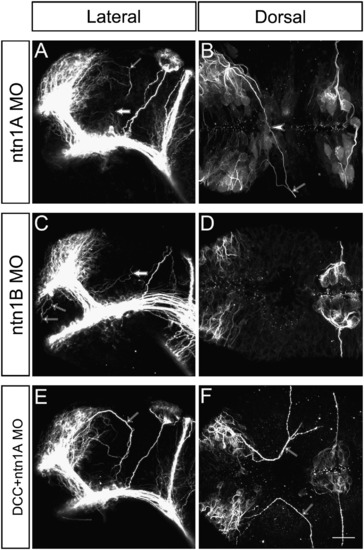Fig. 4
- ID
- ZDB-FIG-120717-20
- Publication
- Gaudin et al., 2012 - Chemoattractant axon guidance cues regulate de novo axon trajectories in the embryonic forebrain of zebrafish
- Other Figures
- All Figure Page
- Back to All Figure Page
|
Knocking down ntn1a, but not ntn1b, reproduces the dcc loss of function phenotype. All images are confocal projections of zebrafish whole-mounted brains at 30 hpf immunolabelled for expression of acetylated α-tubulin. (A) Ectopic axons emerge from the caudal edge of the DRC (thin arrow). The large arrow indicates THC pioneer axons that extend from the ventral diencephalon. (B) Ectopic axons emerge caudally from the DRC. In this example, the tract emerging from the right side of the telencephalon crosses the midline (arrowhead) and invades the contralateral diencephalon before joining the contralateral ectopic axons and continuing the stereotypical curved route to the ventral part of the diencephalon (thin arrow). (C) No ectopic axons are visible in the diencephalic territory caudal to the DRC except for the ventrally located pioneers of the THC (large arrow). Note the axons ventral to the AC that seem to detach themselves from the bulk of the commissure (thin arrows). (D) No ectopic axons are observed in the dorsal diencephalon. (E) The ectopic axon tract follows a stereotypical course through the diencephalon (thin arrow). (F) Ectopic axons (arrows) do not always cross the midline. Scale bars=40 μm (A, C, E), 20 μm (B, D, F). |
Reprinted from Developmental Biology, 367(2), Gaudin, A., Hofmeister, W., and Key, B., Chemoattractant axon guidance cues regulate de novo axon trajectories in the embryonic forebrain of zebrafish, 126-139, Copyright (2012) with permission from Elsevier. Full text @ Dev. Biol.

